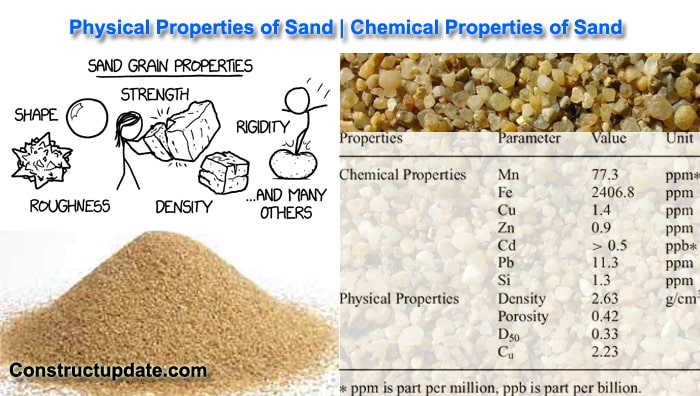Properties of Good Sand | Physical and Chemical Properties of Sand | Quality Test of Sand
Sand can also refer to a type of soil or a textural class of soil, such as one with more than 85 percent sand-sized particles by mass. In this article, we will know about the physical and chemical properties of sand as well as a quality test of good sand.
What is Sand?
Sand is a granular mixture of small rock grains and granular elements that is primarily defined by size, being finer than gravel but coarser than silt. And they come in sizes ranging from 0.06 mm to 2 mm. Silt is defined as particles larger than 0.0078125 mm but smaller than 0.0625 mm.
Given the importance of sand as a construction material, it is usually preferable to utilise high-quality sand. To assess the quality of accessible sand, one must first understand the characteristics of good sand. These desirable features must be confirmed before employing sand in a project.
The physical properties of sands with various primary parameters were thoroughly examined. A total of 200 granular materials were created, including sands and a few artificial compounds. The fundamental physical parameters of all samples were measured, including grain density, shape, and size distribution. All of the samples had some index qualities that characterize physical properties, such as maximum and minimum void ratios, crushability, and sand angle of repose. The relationships between the primary properties and the index properties are examined based on the test results.

Properties of Good Sand:
Following are the desirable properties of sand
- It should be entirely inert, and so have no chemical action.
- Sharp, powerful, and angular grains are ideal.
- There should be no hygroscopic salts in it.
- Clay and silt should be avoided; however, 3-4 percent clay and silt is frequently allowed for practical reasons.
- Organic materials should not be present.
Tests Conducted for Sand:
To determine the qualities of sand, perform the following tests:
- Take a glass of water and fill it with a small amount of sand. After that, it’s forcefully shaking and let to settle. If there is clay in the sand, it forms a distinct layer on top of the sand.
- A solution of sodium hydroxide or caustic soda is added to the sand and agitated to identify the presence of organic contaminants. The presence of organic matter is indicated when the colour of the solution changes to brown.
- The sand is actually tasted, and the presence of salts is determined based on the taste.
- Sand is scooped from a pile and rubbed between the fingers. The presence of earthy particles in the sand is indicated by discolored fingers.
- The purity of sand is determined by its colour. Touching and studying grains with the eye can reveal their size and sharpness.
- Mechanical analysis should be used to determine fineness, durability, void ratio, and other properties of the sand.
The function of Sand in Mortar:
The sand is used in mortar and concrete for the following purposes:
(1) Bulk:
It has no effect on the mortar’s strength. It, on the other hand, functions as an adulterant. As a result, the bulk or volume of mortar is increased, lowering the cost.
(2) Setting:
When fat lime is used as a building material, carbon dioxide is absorbed through the voids in the sand, and fat lime sets effectively.
(3) Shrinkage:
It inhibits excessive shrinkage of the mortar during drying, which prevents breaking of the mortar during setting.
(4) Strength:
It aids in the modification of mortar or concrete strength by varying the percentage of cement or lime. It also improves the mortar’s resistance to crushing.
(5) Surface Area:
It separates the binding material’s paste into a thin film, allowing for increased surface area for spreading and sticking.





